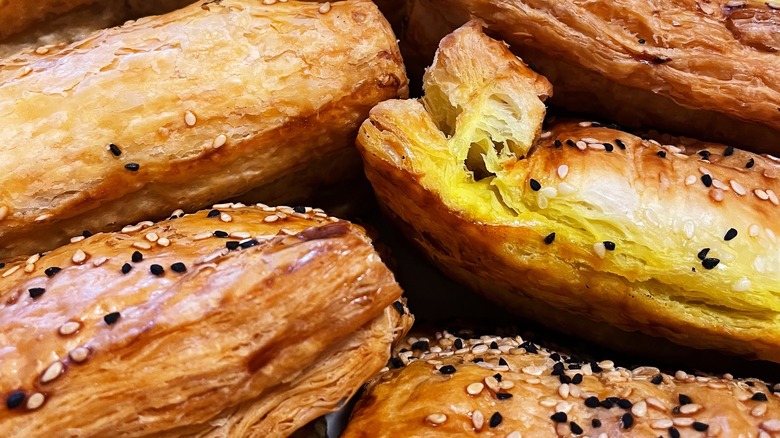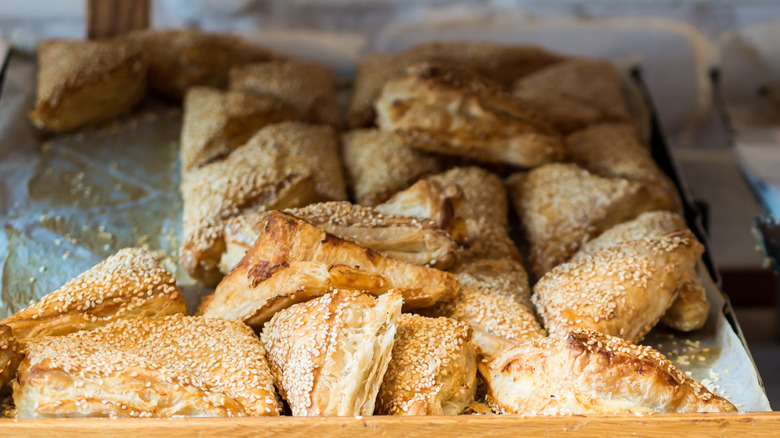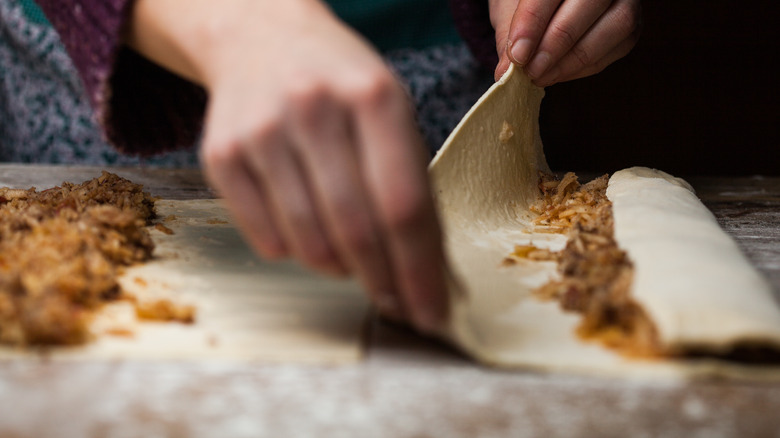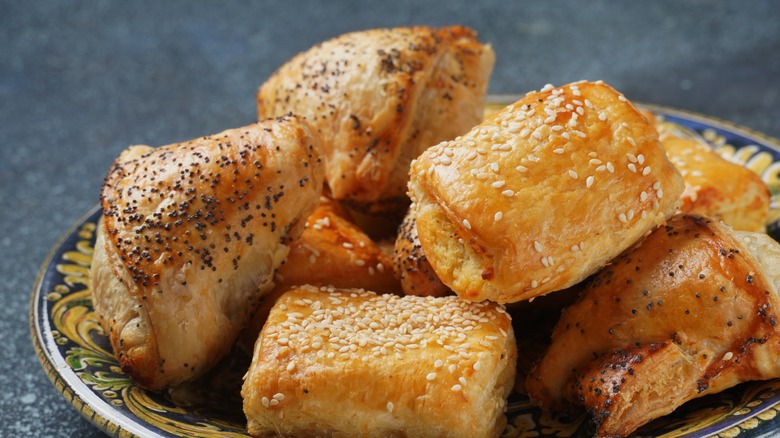Bourekas: The Savory Israeli Pastry You Should Know
You've had empanadas and spanakopita, turnovers and calzones, but have you had boureka? Boureka is a handheld bundle of crisp pastry dough filled with a variety of savory ingredients and is the comfort food of choice for many Israelis.
Israel is a small country, about the size of Massachusetts, according to The University of Minnesota. It is surrounded by three other countries and four bodies of water (via The Baltimore Sun), making it easily accessible and often a thoroughfare for travelers. The influence of a variety of cultures can easily be seen in the large representation of pastries, and foods that seem to belong to no one group in particular, explains Epic and Culture. Film director Roger Sherman describes it as "one of the most dynamic food scenes in the world."
Baked goods and pastries played an essential role in the history of Israel. According to My Jewish Learning, in the late 1800s, communal ovens served as a gathering space where ideas were shared. Later on, pastries were molded by the influence of strudel, which most likely came from Austro-Hungarian immigrants. Variations of strudel like bourekas were quick to follow, but let's dive a bit deeper into the history of this savory pastry.
Bourekas are of Turkish and Spanish descent
Bourekas are said to have originated in Turkey with the immigration of Sephardic Jews from Spain in the late 1400s (via Taste of Jew). It's believed that the term is a combination of the Spanish word 'empanada' and the Turkish word 'borek' meaning hand-held pie. The dough is rumored to stem from a Turkish dough known as "yufka," which was thin and resembled phyllo dough. It is said that Spanish Jews started adding Turkish ingredients to their empanadas and the variations over the years eventually became synonymous with the street food of Israel as Jews migrated further. The dish became so popular that the Turkish sultan Mehmet IV passed a law regulating the price of bourekas in 1680 (via Haaretz).
While bourekas have a family tree spanning most of Central Asia, their tastiness and adaptability have forever cemented them as an Israeli favorite. Haaretz describes them as the Israeli equivalent of Jewish-American bagels and cream cheese because they are expected on every occasion and bring comfort.
Ingredients and how to make them
While it's widely agreed upon that bourekas are a tasty savory pastry, no one seems to agree on whether they should be made with phyllo or puff pastry, per Tori Avey. As MasterClass explains, phyllo dough results in a crispier pastry with thinner layers, while puff pastry is more buttery and airy. One Los Angeles restaurant, Boreka, makes them with their own signature dough that's a cross between phyllo and a croissant, says Eater. In place of margarine, the bakery uses brown butter and the pastries sell out within an hour of opening.
For anyone hoping to make their own, either phyllo dough or puff pastry is rolled thin and then cut into wide strips. Brush each strip with either butter or oil and then spoon your filling of choice on top. Spinach and cheese is a common filling, but eating meat and cheese together is forbidden in Jewish culture, per Jewish Community Center. According to My Jewish Learning, other common vegetarian fillings include eggplant, potatoes, and mushrooms.
Once your filling is in place, fold the pastry over itself until it is closed, brush with oil or butter again, top with sesame seeds, and bake at 350 degrees Fahrenheit for 20 minutes (via My Jewish Learning). In Israel, how the pastry is folded is especially important because the final shape dictates the filling, which is vital for those with dietary restrictions.
Variations and how it's eaten
The brilliance of boureka is that it can be adapted to any dietary need. For a dairy-free version, use oil instead of butter, and vegetables instead of cheese. If you need to make them 'pareve' (yiddish for containing no meat or dairy), use potatoes and eggs. Because of these religious dietary restrictions, laws were put in place in Israel regarding the shape of a boureka so that the dairy and meat-filled pastries wouldn't be confused with vegetarian ones (via Haaretz). A triangular shape means the pastry contains dairy and square or rectangular is vegetarian.
Toppings can also hint at what's inside. Many bourekas are topped with sesame seeds, but other toppings like nigella seeds or a combination of both are found too. Knowing what toppings represent which filling keeps hungry shoppers from pestering the server behind the counter, inquiring what's inside (via Taste of Jew).
Bourekas are great on their own as a quick lunch, but are also served alongside other dishes like soup or salad. The savory pastries can be found in street carts all over Israel served with a hardboiled egg on the side, reports Haaretz. And in homes, the variations of filling and dough is entirely up to the mood and preference of the home chef.
Whether it's a crispy spinach-filled phyllo wrapped pastry or a flaky cheese-filled puffed pie, savory bourekas are a handheld treat you should try.



